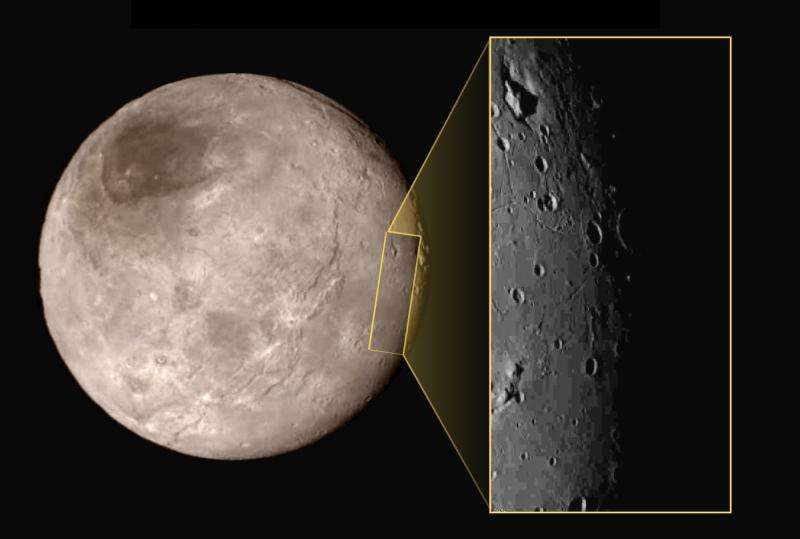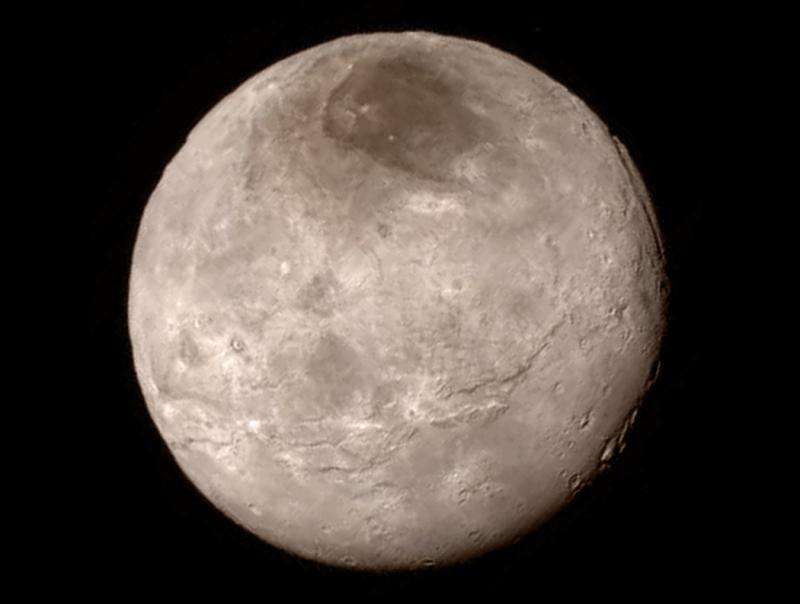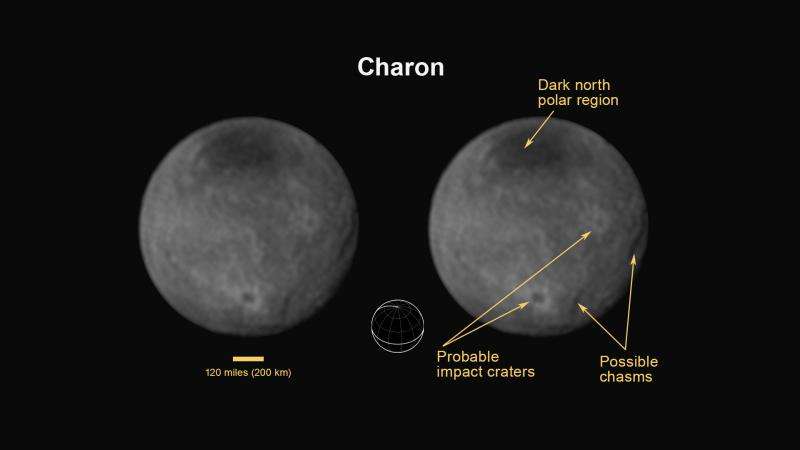This new image of an area on Pluto’s largest moon Charon has a captivating feature — a depression with a peak in the middle, shown here in the upper left corner of the inset. The image shows an area approximately 240 miles (390 kilometers) from top to bottom, including few visible craters. The image was taken at approximately 6:30 a.m. EDT on July 14, 2015, about 1.5 hours before closest approach to Pluto, from a range of 49,000 miles (79,000 kilometers). Credit: NASA-JHUAPL-SwRI
A mysterious mountain in the middle of a moat on Pluto's biggest moon Charon, has captivated and baffled scientists leading NASA's New Horizons mission which made history when it became the first spacecraft to visit our solar system's most distant planet barely two days ago on Tuesday morning, July 14, 2015.
NASA released the first close-up image of Charon today (July 16), shown above, and it has the geology team scratching their heads in amazement and wonder. They can't figure out the nature of a big mountain set inside a moat.
The new image shows a depression with a mountain peak in the middle.
"The most intriguing feature is a large mountain sitting in a moat," said Jeff Moore with NASA's Ames Research Center, Moffett Field, California, who leads New Horizons' Geology, Geophysics and Imaging team. "This is a feature that has geologists stunned and stumped."
The location of the "mountain in a moat" is shown in the inset of a global view of Charon.
The new high resolution image of Charon was taken at approximately 6:30 a.m. EDT (10:30 UTC), barely an hour and a half before the piano-shaped spacecraft's closest approach to Pluto on July 14, 2015, from a range of only 49,000 miles (79,000 kilometers).
The image was captured by New Horizons' high resolution Long Range Reconnaissance Imager (LORRI).
A much sharper view is yet to come, because the image is heavily compressed.
"Sharper versions are anticipated when the full-fidelity data from New Horizons' Long Range Reconnaissance Imager (LORRI) are returned to Earth," say NASA officials.
Altogether it will take 16 months to transmit all the data collected by New Horizons at the Pluto system.
Crisp new view of Pluto’s largest moon, Charon shows a swath of cliffs and troughs stretches about 600 miles (1,000 kilometers) from left to right, suggesting widespread fracturing of Charon’s crust, likely a result of internal processes. At upper right, along the moon’s curving edge, is a canyon estimated to be 4 to 6 miles (7 to 9 kilometers) deep. Credit: NASA-JHUAPL-SwRI
The area in the LORRI image comprises an area approximately 240 miles (390 kilometers) from top to bottom.
Notably there are few visible craters "indicating a relatively young surface that has been reshaped by geologic activity."
Chasms, craters, and a dark north polar region are revealed in this image of Pluto’s largest moon Charon taken by New Horizons on July 11, 2015. The annotated version includes a diagram showing Charon’s north pole, equator, and central meridian, with the features highlighted. Credit: NASA/JHUAPL/SWRI
And a "swath of cliffs and troughs stretching about 600 miles (1,000 kilometers) suggests widespread fracturing of Charon's crust, likely the result of internal geological processes," notes the team.
After a nine year voyage through interplanetary space, New Horizons barreled past the Pluto system on Tuesday, July 14 for a history making first ever flyby at over 31,000 mph (49,600 kph), and survived the passage by swooping barely 7,750 miles (12,500 kilometers) above the planet's amazingly diverse surface.
Source: Universe Today


























